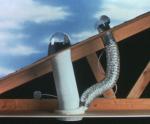Search engine visitors - click here to access entire "$ensible Home" web site
Click here to see a descriptive illustration of several tubular skylight kits.
Dear Jim: I want more natural light so I will need few electric lights on. I am not a big do-it-yourselfer, so a skylight with a lightwell is not an option. Will a tubular skylight help and what other tips are there? - Chris D.

A: Using electric lights in a home is a major energy consumer. Just count up all the light fixtures and lamps, multiply this by 100 watts (the most common incandescent bulb size) and you will realize how much electricity is used.
Using compact fluorescent bulbs can reduce this electricity usage by 75 percent, but the total is still a significant number. Also, during summer, all the heat that light bulbs (any type) create must be removed by your air conditioner so it is a double cost.
Installing a tubular skylight is a good alternative to a standard skylight and is less expensive. I installed a tubular skylight in my own garage where I am building an all-electric car. It provides adequate light for working during the daytime. On a clear night with full moon, my garage is bright enough to walk through without stumbling over car parts.
Most tubular skylight kits are designed similarly. A small tube, usually in the 9- to 21-inch-diameter range, runs from a hole in the roof to a hole in the ceiling below. The interior surface of the tube is highly reflective. Only a low percentage of its brightness is lost as the light reflects back and forth inside the tube as it travels down from the roof.
The roof end is covered by a clear bubble dome. This allows it to catch more light. Some tubular skylights use a prismatic dome designed to capture more of the sun's lower rays, during morning and near evening, and direct them down into the tube. The lower end of the tube, which is flush with the room ceiling, is covered with a frosted diffuser cover so it looks similar to a recessed light.
A tubular skylight will not produce as much light as a large skylight and it obviously provides no attractive view of the sky. As you noted though, installing a skylight in a room with an attic above requires the construction of the lightwell from the ceiling to the roof. This often requires a professional remodeler.
Another advantage of a tubular skylight over a large standard skylight is energy efficiency. Even the best skylights, with efficient glass or triple-pane plastic, have a much lower insulation R-value than the roof. A tubular skylight requires only a small hole from the ceiling to the roof and the interior of the reflective tube is relatively airtight. It will lose much less energy at night than a skylight and gain less heat during the summer.
You have several options when selecting a tubular skylight. First check the roof area for shady spots you should avoid. Also go up into the attic and look for a clear path for the tube from a sunny roof location to the room you want to brighten. The straightest and shortest path for the tube is best. Even though the interior of the tube is highly reflective, up to 98 percent, more length and bends reduce the brightness at the ceiling diffuser.
Most tubular skylight kits include a commonly-used length of straight reflective tubing. If you need elbows or additional tube length to fit around trusses or other obstructions in the attic, they are available from the manufacturers. They generally recommend the maximum length of tube for adequate light.
If you have a problem finding a relatively straight and direct path from the roof to the room ceiling, another option is to install a flexible tubular skylight. These are made of a reflective accordion-like tube which can be flexed around attic obstructions. This makes installation much easily, but some brightness is sacrificed due to the convolutions in the tube wall.
Still another option, if you want several tubular skylights in one room or ones in several rooms, is a grouped design. The reflective tubes run from each of the diffusers in the room(s) to a single opening, similar to a small rectangular skylight in the roof. Various sizes can accommodate two or four tubular skylights.
Some common tips for more natural light are painting your walls a bright, preferably white, color. Hang decorative mirrors on the walls. Install Venetian mini-blinds to allow you to vary the amount of natural light. Without them, uncomfortable afternoon glare may force you to close curtains and switch on a lamp.
Instant Download Update Bulletin No. 920 - buyer's guide of the 8 best skylight tube kit manufacturers showing tube materials, roof dome materials, indoor diffuser materials, diameters available, design type, warranties, features, installation details and many illustrations.
Dear Jim: I live in manufactured housing. The furnace and air conditioner ducts are made of round insulated plastic pipes. I would like to install larger standard metal ducting. Would this be a good thing to do? - Paul M.
A: Insulated round plastic duct is fine. Unless it is damaged or obvious leaking air, don't change it. Round is the most efficient shape for ducts because it has the least surface area for its cross-sectional area.
People often think bigger ducts are better, but this not necessarily true. When the ducts are too big, there is more surface area to lose heat. Also, the air moves through them more slowly and, therefore, more heat is lost.